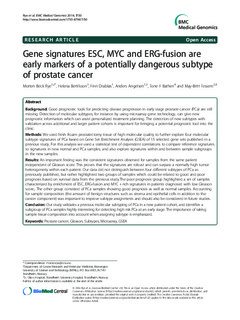| dc.contributor.author | Rye, Morten Beck | |
| dc.contributor.author | Bertilsson, Helena | |
| dc.contributor.author | Drabløs, Finn | |
| dc.contributor.author | Angelsen, Anders | |
| dc.contributor.author | Bathen, Tone Frost | |
| dc.contributor.author | Tessem, May-Britt | |
| dc.date.accessioned | 2019-11-08T08:31:51Z | |
| dc.date.available | 2019-11-08T08:31:51Z | |
| dc.date.created | 2014-11-11T14:32:38Z | |
| dc.date.issued | 2014 | |
| dc.identifier.issn | 1755-8794 | |
| dc.identifier.uri | http://hdl.handle.net/11250/2627320 | |
| dc.description.abstract | Background Good prognostic tools for predicting disease progression in early stage prostate cancer (PCa) are still missing. Detection of molecular subtypes, for instance by using microarray gene technology, can give new prognostic information which can assist personalized treatment planning. The detection of new subtypes with validation across additional and larger patient cohorts is important for bringing a potential prognostic tool into the clinic. Methods We used fresh frozen prostatectomy tissue of high molecular quality to further explore four molecular subtype signatures of PCa based on Gene Set Enrichment Analysis (GSEA) of 15 selected gene sets published in a previous study. For this analysis we used a statistical test of dependent correlations to compare reference signatures to signatures in new normal and PCa samples, and also explore signatures within and between sample subgroups in the new samples. Results An important finding was the consistent signatures observed for samples from the same patient independent of Gleason score. This proves that the signatures are robust and can surpass a normally high tumor heterogeneity within each patient. Our data did not distinguish between four different subtypes of PCa as previously published, but rather highlighted two groups of samples which could be related to good and poor prognosis based on survival data from the previous study.The poor prognosis group highlighted a set of samples characterized by enrichment of ESC, ERG-fusion and MYC + rich signatures in patients diagnosed with low Gleason score,. The other group consisted of PCa samples showing good prognosis as well as normal samples. Accounting for sample composition (the amount of benign structures such as stroma and epithelial cells in addition to the cancer component) was important to improve subtype assignments and should also be considered in future studies. Conclusion Our study validates a previous molecular subtyping of PCa in a new patient cohort, and identifies a subgroup of PCa samples highly interesting for detecting high risk PCa at an early stage. The importance of taking sample tissue composition into account when assigning subtype is emphasized. Keywords: Prostate cancer; Gleason; Subtypes; Microarray; GSEA | nb_NO |
| dc.language.iso | eng | nb_NO |
| dc.publisher | BMC (part of Springer Nature) | nb_NO |
| dc.rights | Navngivelse 4.0 Internasjonal | * |
| dc.rights.uri | http://creativecommons.org/licenses/by/4.0/deed.no | * |
| dc.title | Gene signatures ESC, MYC and ERG-fusion are early markers of a potentially dangerous subtype of prostate cancer | nb_NO |
| dc.type | Journal article | nb_NO |
| dc.type | Peer reviewed | nb_NO |
| dc.description.version | publishedVersion | nb_NO |
| dc.source.volume | 7 | nb_NO |
| dc.source.journal | BMC Medical Genomics | nb_NO |
| dc.source.issue | 50 | nb_NO |
| dc.identifier.doi | 10.1186/1755-8794-7-50 | |
| dc.identifier.cristin | 1171993 | |
| dc.description.localcode | © 2014 Rye et al.; licensee BioMed Central Ltd. This is an Open Access article distributed under the terms of the Creative Commons Attribution License (http://creativecommons.org/licenses/by/4.0), which permits unrestricted use, distribution, and reproduction in any medium, provided the original work is properly credited. The Creative Commons Public Domain Dedication waiver (http://creativecommons.org/publicdomain/zero/1.0/) applies to the data made available in this article, unless otherwise stated. | nb_NO |
| cristin.unitcode | 1920,0,0,0 | |
| cristin.unitcode | 194,65,15,0 | |
| cristin.unitcode | 1920,2,0,0 | |
| cristin.unitcode | 194,65,25,0 | |
| cristin.unitname | St. Olavs Hospital HF | |
| cristin.unitname | Institutt for klinisk og molekylær medisin | |
| cristin.unitname | Kirurgisk klinikk | |
| cristin.unitname | Institutt for sirkulasjon og bildediagnostikk | |
| cristin.ispublished | true | |
| cristin.fulltext | original | |
| cristin.qualitycode | 1 | |

